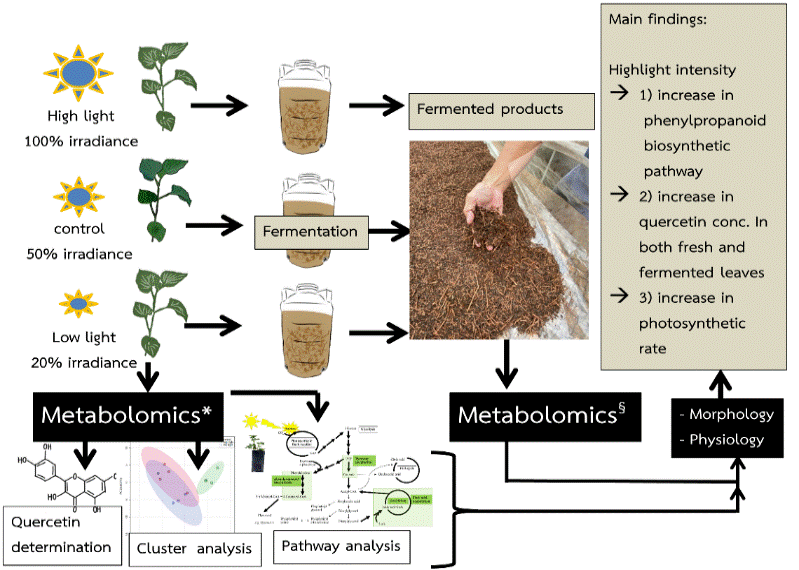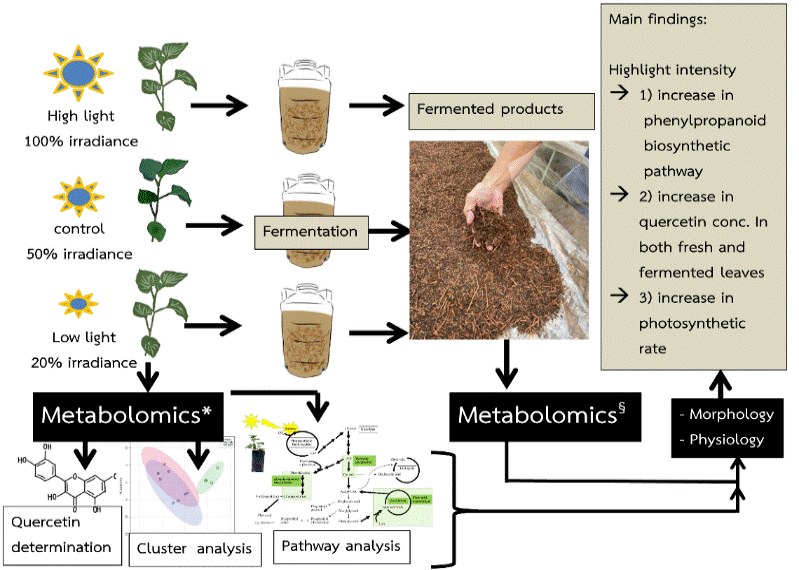Metabolomic and Growth Responses of Houttyunia cordata to Varying Light Intensities and Subsequent Effects on Fermented Products
DOI:
https://doi.org/10.48048/tis.2024.7373Keywords:
Cultivation, Light intensities, Herbs, Metabolomics, Physiology, Fish mint, H. cordataAbstract
Suitable light intensities were studied to enable sustainable and efficient cultivation of Houttuynia cordata with a high yield of bioactive compounds which later can be a good quality material for fermentation. To achieve this goal, the evaluation of physiological adaptation and elucidation of the metabolic alterations of Houttuynia cordata in response to different light intensities were conducted. Four-month-old H. cordata was exposed to 3 different light intensities: high light, control, and low light (100, 50 and 20 % natural irradiances, respectively). Physiological responses were measured using leaf gas exchange. The same leaf samples were either methanolic extracted for LC-QTOF-MS analysis to generate metabolite fingerprints or fermented for 3 months prior to quercetin quantification. High light treatment had the greatest effects on both the physiology and metabolisms of H. cordata compared to control and low light treatments. Compared to the control, the key results observed in high-light-grown H. cordata were a significant increase in photosynthesis, a decrease in relative chlorophyll contents, the enrichment of the top 3 metabolic pathways (phenylpropanoid biosynthesis, pyruvate metabolism and fatty acid degradation) and increasing quercetin concentrations in both fresh and fermented leaves. Metabolite fingerprints of high light-grown H. cordata were distinctively different from those of the other 2 treatments according to PCA and hierarchical clustering analysis. In conclusion, H. cordata responded to high light intensity by enriching the phenylpropanoid biosynthetic pathway to elevate sunscreen pigments. Additional acetyl-CoA generated from pyruvate metabolism and fatty acid degradation was a key supporting factor in the above response. As high quercetin concentration was observed in both fresh and fermented leaves, this will lead to quality improvement of the fermented products.
HIGHLIGHTS
- The remarkable effects of light intensities on Houttuynia cordata growth and abundance of bioactive compounds are substantial, but the underlying mechanism has never been investigated. Metabolomics technology was applied to gain insight into light-induced metabolic reconfiguration.
GRAPHICAL ABSTRACT
Downloads
Metrics
References
K Oginuma, H Sato, Y Kono, S Chen and H Setoguchi. Intraspecific polyploidy of Houttuynia cordata and evolution of chromosome number in the Saururaceae. Chromosome Bot. 2007; 2, 87-91.
M Kumar, SK Prasad and S Hemalatha. A current update on the phytopharmacological aspects of Houttuynia cordata Thunb. Phcog. Rev. 2014; 8, 22-35.
J Fu, L Dai, Z Lin and H Lu. Houttuynia cordata Thunb: A review of phytochemistry and pharmacology and quality control. Chin. Med. 2013; 4, 101-23.
KH Chiow, MC Phoon, T Putti, BK Tan and VT Chow. Evaluation of antiviral activities of Houttuynia cordata Thunb. extract, quercetin, quercetrin and cinanserin on murine coronavirus and dengue virus infection. Asian Pac. J. Trop. Med. 2016; 9, 1-7.
AB Gurung, MA Ali, J Lee, MA Farah, KM Al-Anazi and F Al-Hemaid. Identification of SARS CoV-2 inhibitors from extracts of Houttuynia cordata Thunb. Saudi J. Biol. Sci. 2021; 28, 7517-27.
RH Kwon and BJ Ha. Increased flavonoid compounds from fermented Houttuynia cordata using isolated six of Bacillus from traditionally fermented Houttuynia cordata. Toxicol. Res. 2012; 28, 117-22.
W Sakuludomkan, R Yeewa, S Subhawa, C Khanaree, AI Bonness and T Chewonarin. Effects of fermented Houttuynia cordata Thunb. on diabetic rats induced by a high-fat diet with streptozotocin and on insulin resistance in 3T3-L1 adipocytes. J. Nutr. Metabol.2021; 2021, 6936025.
A Li, S Li, X Wu, H Lu, M Huang, R Gu, L Wei and A He. Influence of light intensity on the yield
and quality of Houttuynia cordata. Plant Prod. Sci. 2015; 18, 522-8.
S Boonchaisri, S Rochfort, T Stevenson and DA Dias. LC-MS untargeted metabolomics assesses the delayed response of glufosinate treatment of transgenic glufosinate resistant (GR) buffalo grasses (Stenotaphrum secundatum L.). Metabolomics 2021; 17, 28.
RJV Alves, D Medeiros, RL Moura, LCT Gusmao, NG Silva, K Antunes, C Matozinhos and MA Blanco. First report of naturalization of Houttuynia cordata Thunb. 1783 (Piperales:Saururaceae) in South America. Check List 2013; 9, 642-4.
J Uddling, J Gelang-Alfredsson, K Piikki and H Pleijel. Evaluating the relationship between leaf chlorophyll concentration and SPAD-502 chlorophyll meter readings. Photosynth Res. 2007; 91, 37-46.
MD Sarkar, MJ Rahman, J Uddain, M Quamruzzaman, MOK Azad, MH Rahman, MJ Islam, MS Rahman, KY Choi and MT Naznin. Estimation of yield, photosynthetic rate, biochemical, and nutritional content of red leaf lettuce (Lactuca sativa L.) grown in organic substrates. Plants 2021; 10, 1220.
S Li, Y Park, S Duraisingham, FH Strobel, N Khan, QA Soltow, DP Jones and B Pulendran. Predicting network activity from high throughput metabolomics. PLoS Comput. Biol. 2013; 9, e1003123.
W Oh and KS Kim. Light intensity and temperature regulate petiole elongation by controlling the content of and sensitivity to gibberellin in Cyclamen persicum. Horticulture Environ. Biotechnol. 2014; 55, 175-82.
RD Butler. The effect of light intensity on stem and leaf growth in broad bean seedlings. J. Exp. Bot. 1963; 14, 142-52.
JH Kang, SK Kumar, SLS Atulba, BR Jeong and SJ Hwang. Light intensity and photoperiod influence the growth and development of hydroponically grown leaf lettuce in a closed-type plant factory system. Horticulture Environ. Biotechnol. 2013; 54, 501-9.
G Zervoudakis, G Salahas, G Kaspiris and E Konstantopoulou. Influence of light intensity on growth and physiological characteristics of common sage (Salvia officinalis L.). Braz. Arch. Biol. Tech. 2012; 55, 89-95.
H Roman, T Girault, F Barbier, T Péron, N Brouard, A Pěnčík, O Novák, A Vian, S Sakr, L Lothier, JL Gourrierec and N Leduc. Cytokinins are initial targets of light in the control of bud outgrowth. Plant Physiol. 2016; 172, 489-509.
A Corot, H Roman, O Douillet, H Autret, MD Perez-Garcia, S Citerne, J Bertheloot, S Sakr, N Leduc and S Demotes-Mainard. Cytokinins and abscisic acid act antagonistically in the regulation of the bud outgrowth pattern by light intensity. Front. Plant Sci. 2017; 8, 1724.
Z Ma, S Li, M Zhang, S Jiang and Y Xiao. Light intensity affects growth, photosynthetic capability, and total flavonoid accumulation of Anoectochilus plants. HortScience 2010; 45, 863-7.
S Rezai, N Etemadi, A Nikbakht, M Yousefi and MM Majidi. Effect of light intensity on leaf morphology, photosynthetic capacity, and chlorophyll content in Sage (Salvia officinalis L.). Horticultural Sci. Tech. 2018; 36, 46-57.
NQ Dong and HX Lin. Contribution of phenylpropanoid metabolism to plant development and plant-environment interactions. J. Integr. Plant Biol. 2021; 63, 180-209.
MR Hemm, SD Rider, J Ogas, DJ Murry and C Chapple. Light induces phenylpropanoid metabolism in Arabidopsis roots. Plant J. 2004; 38, 765-78.
S Zhou, SF Yuan, PH Nair, HS Alper, Y Deng and J Zhou. Development of a growth coupled and multi-layered dynamic regulation network balancing malonyl-CoA node to enhance (2S)-naringenin biosynthesis in Escherichia coli. Metab. Eng. 2021; 67, 41-52.
F Gibellini and TK Smith. The Kennedy pathway-de novo synthesis of phosphatidylethanolamine and phosphatidylcholine. IUBMB Life 2010; 62, 414-28.
A Cagliari, R Margis, FDS Maraschin, AC Turchetto-Zolet, G Loss and MM Pinheiro. Biosynthesis of triacylglycerols (TAGs) in plants and algae. Int. J. Plant Biol. 2011; 2, e10.
KEGG: Kyoto Encyclopedia of Genes and Genomes, Available at: https://www.genome.jp/pathway/map00940, accessed February 2023.
C Liu, S Feng, Q Wu, H Huang, Z Chen, S Li and Y Xu. Raw material regulates flavor formation via driving microbiota in Chinese liquor fermentation. Front. Microbiol. 2019; 10, 1520.
RK Salar, M Certik and V Brezova. Modulation of phenolic content and antioxidant activity of maize by solid state fermentation with Thamnidium elegans CCF 1456. Biotechnol. Bioproc. Eng. 2012; 17, 109-16.
JCD Río, J Rencoret, A Gutiérrez, T Elder, H Kim and J Ralph. Lignin monomers from beyond the canonical monolignol biosynthetic pathway: Another brick in the wall. ACS Sustain. Chem. Eng. 2020; 8, 4997-5012.

Downloads
Published
How to Cite
Issue
Section
License
Copyright (c) 2023 Walailak University

This work is licensed under a Creative Commons Attribution-NonCommercial-NoDerivatives 4.0 International License.






